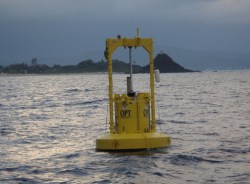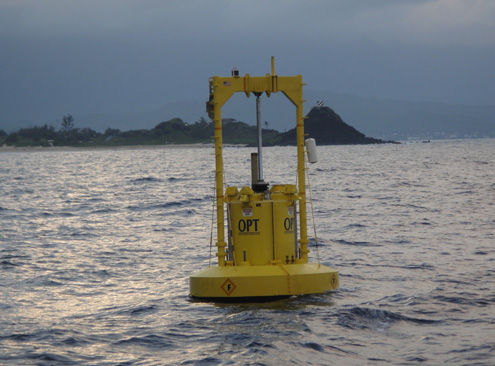For more than a century, people have tried to figure out how to turn the endless, repetitive motion of the waves into a source of energy. At Wired, author Alexis Madrigal outlined some of the bizarre contraptions intended to serve that purpose, metal and wood constructions depicted in complex diagrams that evoke alchemy more than science. As Madrigal notes, more than a thousand patents for converting waves into electricity exist, which “generally didn’t work at all or only worked for a short period of time.”

An Ocean Power Technologies buoy.
Enter Ocean Power Technologies. The New York Times reports:
[T]he first commercially licensed grid-connected wave-energy device in the nation, designed by a New Jersey company, Ocean Power Technologies, is in its final weeks of testing before a planned launch in October. The federal permit for up to 10 generators came last month, enough, the company says, to power about 1,000 homes. When engineers are satisfied that everything is ready, a barge will carry the 260-ton pioneer to its anchoring spot about two and a half miles offshore near the city of Reedsport, on the central coast [of Oregon].
Ocean Power Technologies is not to be confused with Ocean Renewable Power Company, which uses turbines on the floor of a body of water to generate energy from tidal flows. The Ocean Power buoys sit on the surface of the water, bobbing up and down as waves pass by.
On the Ocean Power Technologies buoy, which looks like a giant cannon stuffed with electronics, company engineers pursued an insight that sailors have known in their sea legs since the days of Odysseus: every wave is different.
The onboard computer in each buoy, in communication with an array of small devices called wave riders that float farther out in the ocean, adapts, or “tunes” to each incoming wave, adjusting the way the giant internal shaft rides up and down as the swell passes through. The up-and-down motion of the shaft creates the electricity, which goes to shore through a seabed cable.
In a nod to environmental concerns, the buoy was redesigned to remove all hydraulic fluids, which some critics feared could contaminate the water in the event of an accident; rack-and-pinion gears now drive the mechanics. The three anchoring tethers, said Michael G. Kelly, the vice president of operations at Ocean Power Technologies, were also built to withstand a 100-year storm, but also with enough redundancies that even if two anchors failed the third would be enough to keep the buoy in place.
Ocean Power has already installed its buoys (dubbed by its marketing team as PowerBuoys) off the coasts of New Jersey, Scotland, and Oahu — at a Marine Corps base, part of the Navy’s ongoing efforts to promote renewable energy. The deployment in Oregon will be the company’s largest and, as the Times article suggests, most public.
After a century, we may finally have mastered wave-based power. Turns out those inventors back in the day just needed some microelectronics. If they’d only known.



